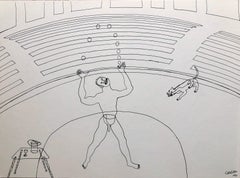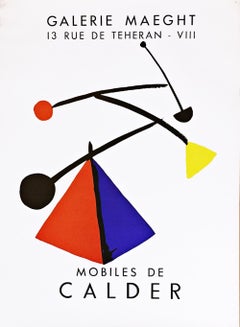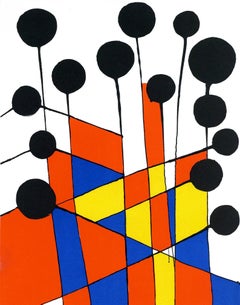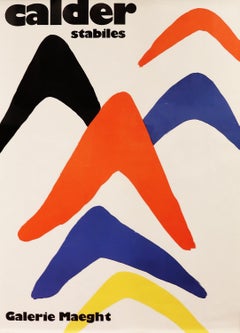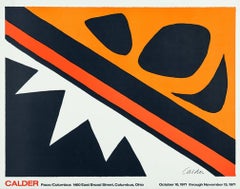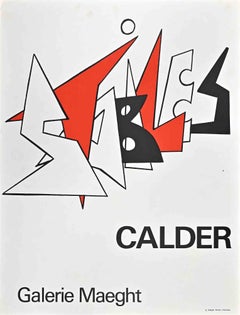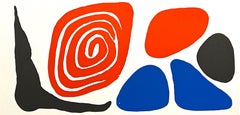After Calder Mobiles
1930s American Modern Animal Prints
Lithograph
1930s American Modern Animal Prints
Lithograph
1930s American Modern Animal Prints
Lithograph
Mid-20th Century Abstract Abstract Prints
Lithograph, Offset
1970s Modern Figurative Prints
Lithograph
20th Century Surrealist Abstract Prints
Color
1970s Contemporary Prints and Multiples
Lithograph, Offset
1970s Contemporary More Prints
Lithograph
1970s Modern Still-life Prints
Lithograph
1970s Modern Still-life Prints
Lithograph
1960s Modern Still-life Prints
Lithograph
1960s Modern Still-life Prints
Lithograph
1960s Modern Still-life Prints
Lithograph
1960s Modern Still-life Prints
Lithograph
1960s Modern Still-life Prints
Lithograph
1960s Modern Still-life Prints
Lithograph
1960s Modern Still-life Prints
Lithograph
1970s Modern Still-life Prints
Lithograph
1960s Modern Still-life Prints
Lithograph
1960s Modern Still-life Prints
Lithograph
1960s Modern Still-life Prints
Lithograph
1960s Modern Still-life Prints
Lithograph
1960s Modern Still-life Prints
Lithograph
1960s Modern Still-life Prints
Lithograph
1960s Modern Still-life Prints
Lithograph
1970s Modern Still-life Prints
Lithograph
1970s Modern Still-life Prints
Lithograph
1970s Modern Still-life Prints
Lithograph
1970s Modern Still-life Prints
Lithograph
1970s Modern Still-life Prints
Lithograph
1970s Modern Still-life Prints
Lithograph
1970s Modern Still-life Prints
Lithograph
1970s Modern Still-life Prints
Lithograph
1970s Modern Still-life Prints
Lithograph
1970s Modern Still-life Prints
Lithograph
1970s Modern Still-life Prints
Lithograph
1950s Modern Still-life Prints
Lithograph
1960s Modern Still-life Prints
Lithograph
1960s Modern Still-life Prints
Lithograph
1960s Modern Still-life Prints
Lithograph
1960s Modern Still-life Prints
Lithograph
1960s Modern Still-life Prints
Lithograph
1970s Modern Still-life Prints
Lithograph
1970s Modern Still-life Prints
Lithograph
1970s Modern Still-life Prints
Lithograph
1970s Modern Still-life Prints
Lithograph
1970s Modern Still-life Prints
Lithograph
1970s Modern Still-life Prints
Lithograph
1950s Modern Still-life Prints
Lithograph
1970s Modern Still-life Prints
Lithograph
1970s Modern Still-life Prints
Lithograph
1970s Modern Still-life Prints
Lithograph
1970s Modern Still-life Prints
Lithograph
1970s Modern Still-life Prints
Lithograph
1960s Abstract Abstract Prints
Lithograph
1960s Abstract Abstract Prints
Lithograph
1960s Modern Abstract Prints
Lithograph
1970s Abstract Expressionist Abstract Prints
Lithograph
1960s Modern Still-life Prints
Lithograph
Mid-20th Century American Posters
Paper
- 1
After Calder Mobiles For Sale on 1stDibs
How Much are After Calder Mobiles?
- What is a Calder mobile?1 Answer1stDibs ExpertNovember 2, 2021A “Calder mobile” refers to a moving artwork created by American sculptor Alexander Calder composed of delicately balanced sculptural forms suspended from the ceiling. Calder worked a number of jobs, including as a hydraulic engineer and draftsman for the New York Edison Company, before deciding to pursue an artistic career. He never abandoned his engineering background, however, applying his understanding of gears and moving parts in all his artworks, from mechanical toys like the Cirque Calder (1931) and his revered prints to his free-standing abstract sculptures, called stabiles. Find a collection of original Alexander Calder art on 1stDibs.
- 1stDibs ExpertOctober 12, 2021The American sculptor Alexander Calder is known as the father of the mobile, a moving artwork composed of delicately balanced sculptural forms suspended from the ceiling. On 1stDibs, find a variety of vintage Alexander Calder drawings and other sculptures.
- 1stDibs ExpertApril 5, 2022Alexander Calder's mobiles were revolutionary because he largely pioneered the art form of creating hanging sculptures that were able to move freely in response to airflow. Calder was a prolific artist believed to have produced more than 22,000 works during his life. Shop a variety of Alexander Calder art on 1stDibs.
- 1stDibs ExpertApril 5, 2022Artist Alexander Calder used primarily industrial materials to create his mobile, such as steel, aluminum and wire. With a background in mechanical engineering, Alexander Calader uses his education to build mobiles with seemingly impossible silhouettes that make for eye-catching decor pieces. Shop a selection of Alexander Calder work on 1stDibs.
- 1stDibs ExpertApril 5, 2022The term ‘mobile’, which was coined by Marcel Duchamp, was used to describe Alexander Calder’s work, as Calder’s sculptures often moved with the help of motors or wind. ‘Mobiles’ was a French pun which meant ‘motion’. On 1stDibs, find a variety of original artwork from Alexander Calder.
- What is a hanging mobile?1 Answer1stDibs ExpertApril 5, 2022A hanging mobile is a three-dimensional artwork that rotates or spins when the air around it moves. Art historians credit Alexander Calder with producing the first mobiles but believe the artist Marcel Duchamp named them. Find a variety of hanging mobile art on 1stDibs.
- 1stDibs ExpertApril 5, 2022The American sculptor Alexander Calder invented the mobile, a moving artwork composed of delicately balanced sculptural forms suspended from the ceiling. His mobiles were an innovative feat and initially used motors for movement, which he later abandoned for air currents alone. Calder was also a pioneer of wire sculptures. Shop a selection of Alexander Calder pieces from some of the world’s top art dealers on 1stDibs.
- Where is Alexander Calder’s art?1 Answer1stDibs ExpertApril 5, 2022Alexander Calder’s artwork has found its home in many museums and art galleries around the world, including the Museum of Modern Art and the Guggenheim Museum. Shop a selection of Alexander Calder’s pieces from some of the world’s top art dealers on 1stDibs.
- How did Calder become an artist?1 Answer1stDibs ExpertMarch 13, 2024The story of how Calder became an artist begins with his parents. Both artists themselves, they did not want him to suffer the hardships of trying to make a living in art, so they encouraged the young Alexander Calder to study mechanical engineering at the Stevens Institute of Technology in Hoboken, New Jersey. He subsequently worked a number of jobs, including as a hydraulic engineer and draftsman for the New York Edison Company, before deciding to pursue an artistic career. He applied his engineering background to his artwork, such as his understanding of gears and moving parts for kinetic sculptures like Cirque Calder (1931) and free-standing abstract sculptures he called “stabiles.” Explore a selection of Alexander Calder art on 1stDibs.
- 1stDibs ExpertApril 5, 2022American artist Alexander Calder is best known for his work in sculpture, particularly his monumental sculptures and innovative ‘mobiles’ in the tradition of kinetic art. Shop a collection of authentic Alexander Calder pieces from some of the world’s top art dealers on 1stDibs.
- 1stDibs ExpertMay 3, 2024Alexander Calder mostly made sculptures, although he also worked in printmaking, painting, performance and other media. He is known as the father of the mobile, a moving artwork composed of delicately balanced sculptural forms suspended from the ceiling. Some of his most famous works include Cirque Calder, A Universe, Josephine Baker (III), Mobile (Arc of Petals), Devil Fish, Romulus and Remus and Fish. On 1stDibs, find a variety of Alexander Calder art.
- 1stDibs ExpertMarch 22, 2022Alexander Calder is best known for his sculptures. He produced large, playful freestanding and hanging works in vibrant colors. Examples include Mobile-Stabile, Lobster Trap and Fish Tail and Flying Dragon. On 1stDibs, you can shop a selection of Alexander Calder art.
- 1stDibs ExpertApril 16, 2024Alexander Calder used many of the elements of art when producing his works. The American sculptor is known as the father of the mobile, a moving artwork composed of delicately balanced sculptural forms suspended from the ceiling. These kinetic pieces use color, shape and space to convey a sense of unity, and the form of the art allows it to interact with its environment. Find a variety of Alexander Calder art on 1stDibs.
- 1stDibs ExpertApril 3, 2024Alexander Calder invented the mobile, a moving artwork composed of delicately balanced sculptural forms suspended from the ceiling. The revered American sculptor's mobiles were an innovative feat and initially used motors for movement, which he later abandoned for air currents alone. Calder was also a pioneer of wire sculptures. (He was a celebrated modernist printmaker, too, and while jewelry was a secondary métier for him, interest in his wearable art has accelerated in recent years.)
For Calder, the fascinating moment of artistic alchemy comes sometime between his representational canvases of the late 1920s and 1931, the year of his first show of abstract sculpture. Moving to Paris helped spur his creativity, as it did for so many artists and writers. The moment Calder arrived, he began working on one of his most seminal pieces, Cirque Calder (1931), his delightful distillation of the circus into what are essentially three-dimensional line drawings made with wire.
Shop authentic Alexander Calder prints, sculptures and other art from some of the world’s top art dealers on 1stDibs. - 1stDibs ExpertMay 3, 2024The art movement that Alexander Calder was connected to was kinetic art. The term refers to art that moves or has the appearance of movement. With their ability to sway and turn once suspended, Calder's mobiles are often referenced as examples of kinetic art. On 1stDibs, find a selection of Alexander Calder art.
- 1stDibs ExpertApril 5, 2022There are several interpretations of how to describe the characteristics of Alexander Calder’s sculptures. Some say they are abstract, with life-like elements, others say they are flat, simplified shapes that intersect at opposing angles. See the magic for yourself — shop a selection of Alexander Calder pieces from some of the world’s top art dealers on 1stDibs.
- 1stDibs ExpertMarch 13, 2024Alexander Calder produced more than 22,000 works of art during his lifetime. The prolific artist made paintings, drawings, prints, tapestries, stage sets, jewelry and other types of art. Some of his most famous pieces include Cirque Calder, Josephine Baker (III), A Universe, Mobile (Arc of Petals) and Devil Fish. Shop a diverse assortment of Alexander Calder art on 1stDibs.
- 1stDibs ExpertApril 5, 2022Like all meaningful works of art, the mood that best describes American artist Alexander Calder’s sculptures is subject to interpretation. Common descriptors for his abstract work include “playful” or “whimsical.” Calder is best known as the father of the mobile, a moving artwork composed of delicately balanced sculptural forms suspended from the ceiling. Shop a selection of Alexander Calder pieces from some of the world’s top art dealers on 1stDibs.
Read More
Art Brings the Drama in These Intriguing 1stDibs 50 Spaces
The world’s top designers explain how they display art to elicit the natural (and supernatural) energy of home interiors.
Welcome (Back) to the Wild, Wonderful World of Walasse Ting
Americans are rediscovering the globe-trotting painter and poet, who was connected to all sorts of art movements across a long and varied career.
Shapero Modern’s Director Tells Us All about 20th-Century Prints
Tabitha Philpott-Kent knows a lot of art multiples. Here, the London gallery director talks about what makes printmaking so fabulous.
Yoshitomo Nara Puts a Punk Rock Twist on the Traditional Prints of His Ancestors
The forever-rebellious Japanese artist craftily defaces famous Edo Period woodblock prints with “In the Floating World.”
Red Grooms Salutes the ‘Ninth Street Women’ Who Revolutionized Modern Art
In a new show of peppy portraits, the 85-year-old artist looks back at 1950s New York, when the Abstract Expressionists ruled the scene. Only now, the women Ab-Ex artists get more of the spotlight than the men.
Just What Is an Intaglio Print, and What Makes It a Good Investment?
Bay Area art publisher Rhea Fontaine explains the difference between intaglio and woodcut printing, how to frame fine art prints and what makes them attractive to collectors.
Andy Warhol Piles Up the Gifts in This Fanciful Christmas Print
Created in the late 1950s, it’s one of a surprising number of holiday-themed works by the prolific Pop artist.
A Derrick Adams Double Portrait Brings Out the Interior Lives of His Subjects
Adams has skyrocketed to art superstardom with his exuberant depictions of Black life. Here's what makes his work important to our times.

